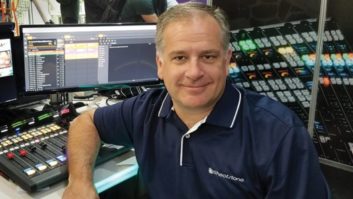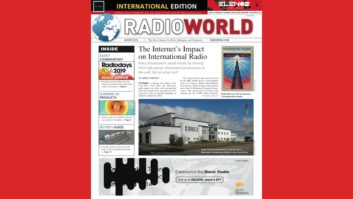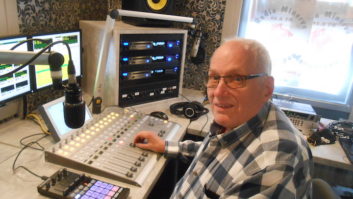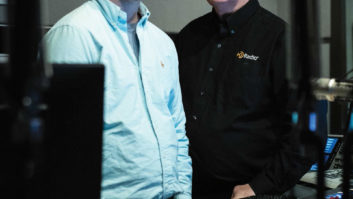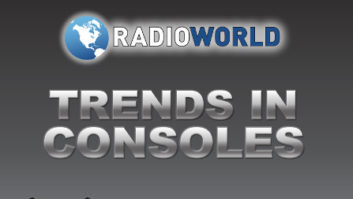Digital Consoles: More Power for Less Money
Aug 1, 2002 12:00 PM, By Steve Fluker
Many digital console designs can be operated as complete stand-alone units, or they can be integrated with audio engines and router frames for greater versatility.

Since the mid-1980s, radio station control rooms have been evolving from analog to digital, first with CDs and then DAT. Before long, reel-to-reel recorders were replaced by computer digital editors, and portable cassettes were replaced with mini-disc recorders. Even the CD is now being replaced by computer audio storage.
As digital technology evolved, more and more equipment was being designed with digital inputs and outputs. Unfortunately, engineers had to ignore these digital ports and continue to use the balanced audio standards because of the limited availability of digital audio consoles. When the first digital on-air consoles hit the market, they were expensive, controlled by a computer that made them subject to crashing, and had fixed numbers of digital and analog inputs, making them less flexible. Today there are a wide variety of digital boards designed to fit any need and budget so there is no excuse for not considering them.
More complex than analog
One of the reasons for the late arrival of digital consoles was the complexity of their design. An analog design passes the audio through an adjustable resistor or potentiometer and through a buffer audio stage, and then bridges the output of multiple channels to a common mixing bus (see Figure 1). Digital no longer deals with a varying analog voltage, but rather changing the digital data itself. Passing data through a device isn’t the problem. Varying the volume and mixing digital data streams makes it more complicated.

Figure 1. A block diagram of a traditional analog audio console.
Figure 2 shows one method of adjusting and mixing the audio digitally. A digital data input feeds a level processor that, like a calculator, performs a mathematic function to the signal. The console pot provides a control signal that instructs the processor to vary the digital signal level. The converted data is used as a multiplier of the original digital audio data. (See A Point Worth Making at this link.) The level of each input must be individually adjusted and then mixed together. Like the analog counterpart, this mix process sums the data of all the inputs into a new digital bitstream.
Figure 2. Conceptual diagram of a digital audio console.
New flexibility for digital
To be practical for a radio control room, consoles must have the flexibility of accepting digital and analog inputs. To accomplish this, an analog input will pass through an A/D converter. Manufacturers use a variety of methods to handle the conversion of analog inputs. Some have different modules for analog or digital inputs, which are ordered according to specific needs, much like ordering microphone or line input modules on analog consoles. Others use one type of module with a separate add-on circuit board used to select digital or analog. This method gives a one-module-fits-all solution and makes future changing of a module from analog to digital easy and relatively inexpensive. Some of the high-end consoles will have A/D converters available for any input allowing the user to easily make changes in the console configuration without purchasing anything new.
When designing a new studio, carefully consider the audio console. With so many available options, don’t rely on what you already know. While modular analog consoles are still available and work well for some applications, there are newer and better ways to control audio. The first consideration is to decide if the studio will be part of a consolidation project and one of many studios in the facility, or if it is to be used as a stand-alone installation. Next, note every source that will be needed in the room. For larger projects, consider a console that can be easily interfaced to a routing switcher system. Many modular consoles offer custom drop-in modules, which are compatible with many of the popular routing switchers on the market and actually serve as a controller for the switcher. These replace the old remote line selectors and allow selection of any source that is connected to the router instead of being limited to just eight or 10 inputs. Some of the newer consoles also provide serial data ports, which can connect directly to the router and will allow routing of the machine logic.
A router-based design relies on an audio engine to handle the routing and mixing functions. The consoles are just control surfaces.

Another type of console is the router-based console. These control surfaces don’t use individual modules with audio inputs and outputs, but rather directly control the audio inside the routing switcher itself. With this type of system, the mixing bus for the console is created in a single routing-switcher output. Typically, a single output of the routing switcher will actually have as many as 24 or more internal mixing cells, with the volume level of each cell individually controlled by a different pot on the console. There are several benefits to this type of arrangement, the main advantage being flexibility. All audio sources and their associated remote control functions are connected to the routing switcher and become a pool of sources. This allows any source to appear in any studio, on any console or even multiple locations on a control surface. These systems can allow literally hundreds of inputs to be available on a single console and every pot on the board becomes a routing-switcher controller/selector. These consoles can be programmed so that each announcer can have his own layout on the console. This is great for complex formats such as news-talk stations. Another benefit is that the electronics and wiring are dramatically reduced. These consoles typically are connected with one CAT5 cable, a multi-conductor cable for GPI logic inputs and outputs, and a power cord. While they might not be modular in design, they are lightweight, and one person can swap an entire console in as little as five minutes without taking the station off the air or causing a glitch in the audio. This is because there is no audio passing through the console. Think of the console as a fancy keyboard to a computer. All of the audio inputs and outputs are connected and remain in the routing switcher itself. With the reduction of electronics comes a lower price as well. You may be surprised at how much more you can do for the same money you would spend on a conventional router and control console.
There is a downside. Because there are no direct inputs or outputs on the control board, outputs from microphones and CD players must be wired out of the control room to the equipment room to be directly connected into the routing switcher. Still, you will find a significant reduction in wiring between the equipment room and control room.
Some manufacturers are introducing hybrid systems to address this rack room/control room routing issue. Routing control modules are used for the sources coming from outside of the room. Direct inputs are provided within a room for sources that originate there. In most cases, these local sources still appear on the central routing system and are available elsewhere in the facility. These hybrid systems still use serial ports connected to the routing switcher for control of the common sources and logic on the router.
Digital features
As digital technology continues to move forward so do the features and capabilities of the consoles. Control boards with digital displays to indicate the source of each pot are common. This eliminates the added expense for etching legends on the on/off button caps, and prevents the unsightly label-maker tape stuck to everything.
Smaller control surfaces can be used to provide complete access to all audio sources and destinations without occupying a large space.

More features now appear on the consoles as well. Digital consoles now have built-in microphone processors, equalizers, compressor/limiters and other digital effects such as reverb and flanging, which can be used on any channel on the control surface. While some of the high-profile talent may still want to use their favorite outboard processors, the quality of these built-in digital effects is good, and they are ideal for processing RPU receivers and codecs, or cleaning up telephone caller audio. It can also be a cost-saving measure for smaller-market stations, eliminating the need for expensive outboard processing and effects. The built-in processing can be assigned not only to inputs, but also to any of the output buses as well. This gives the user the ability to take a clean program mix bus to an air chain, then take a second program mix bus, specially processed within the console, and feed it to other sources such as a streaming audio server. Digital consoles also provide more auxiliary and mix/minus buses than their analog counterparts, thus addressing the needs of complex formats. Expect to see more features in the future such as a built-in obscenity delay for morning and talk shows. With the built-in digital effects and the ability to accept any type of input source (AES, SPDIF, fiber, analog balanced and unbalanced), thousands of dollars can be saved on outboard processing and matching devices.
Manufacturers need to remember to keep the control room console simple and not make drastic changes that the on-air announcers must deal with. Announcers like to say that they have the latest in technology but don’t like to deal with job changes.
The production room is a different story. New production consoles have built-in features that rival, and in some cases outperform, some of the best outboard effects. They can also directly interface with digital editors to offer a complete package with full automation of faders, EQ, panning and digital effects. Because they can be complex, many of these consoles allow all of the settings to be stored as a project. Any saved project can be instantly restored. These new production consoles offer incredible power at exceptional prices. A fully loaded digital production board with built-in effects and more than 70 inputs can cost less than $10,000. Once again, there is a downside. These consoles have become complex and take time to learn to operate. This is not a problem for the production manager who uses it every day, however, it can be intimidating for announcers or other staff members to come in and quickly record a voice track. Having a smaller, more traditional dub room available for this type of work may be useful.
Take time to pre-plan a new studio before jumping into a console purchase. It takes a change in your way of thinking, but with proper planning, you will be able to have a state of the art digital facility with flexibility you probably never thought about all for a price tag that might be less than you imagined.
Fluker is the director of engineering of Cox Radio, Orlando, FL.






